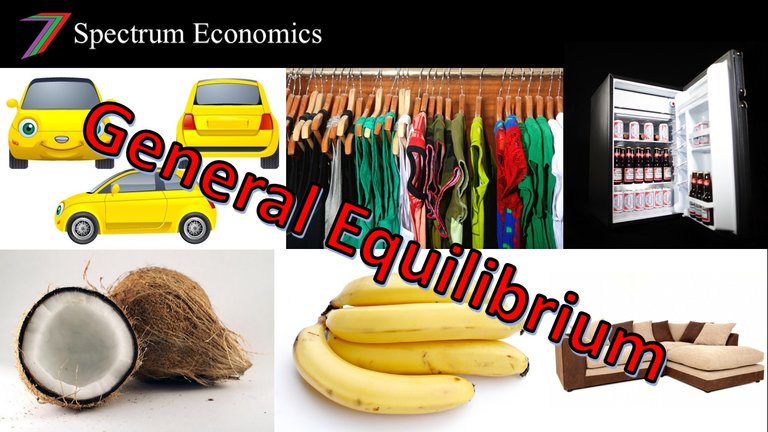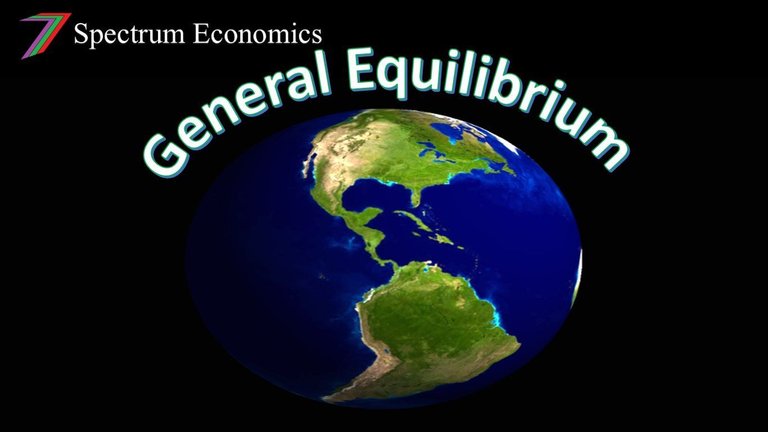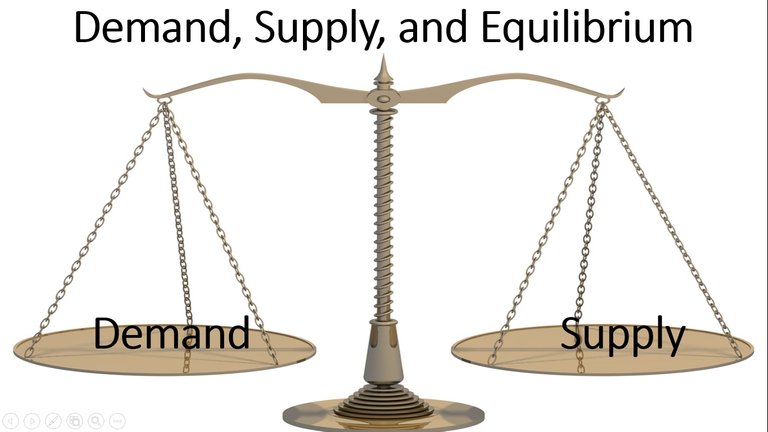
This is a short video briefly explaining general equilibrium theory. The analysis of demand and supply is typically conducted from a ‘partial equilibrium’ perspective. Partial equilibrium considers the impact of direct determinants of demand and supply on only one market. Partial equilibrium provides a good sense of the relationship between price and quantity of one particular good or service but does not factor the impact changes in other markets might have on demand and supply.
What is general equilibrium theory?
General equilibrium theory considers multiple markets when determining changes in price and output. General equilibrium considers the relationships between various markets. Are goods and services complementary or substitutes to each other? What ripple effects occur because of a change in demand or supply of one or several goods and services?
How is general equilibrium conducted?
General equilibrium can be applied using input output models or computable general equilibrium (CGE) models. These models are highly complex and consist of thousands of algorithms and require enormous amount of data. CGE models are considerably more detailed than input output models. Some economists dedicate their entire careers to just refining these very complex models.
When is general equilibrium theory applied?
General equilibrium analysis is applied to policies and decisions that have significant impact on the economy. These policies could relate to changes in the tax rate, changes to interest rates, very large government expenditure, or the introduction of game changing technology.
General equilibrium models are rarely applied. This is because they are very expensive to run, require large quantities of data, require economists with a very particular skill set, and are very time consuming.
How general equilibrium is explained in the video
The video explains general equilibrium using two examples. The first example is the Robinson Crusoe model. The Robinson Crusoe model looks at a very basic example of a person (Robinson Crusoe) who is required to provide for himself. He needs to balance his time between collecting bananas and coconuts. The example demonstrates how Robinson Crusoe must optimise his skills as well as cater to his own tastes. The model explains the relationship between Robinson Crusoe’s abilities to collect coconuts and bananas and his taste for coconuts and bananas. The example also demonstrates the trade-off between coconuts and bananas which Robinson Crusoe is required to understand.
The second example is a brief explanation of a very basic input output model. The model demonstrates how firms depend on other firms within the same industry as well as firms from other industries. For example, if there was a direct increase in quantity demand for Product A, there will also be an increase in quantity demanded for all inputs into Product A. This will lead to an increase in inputs into the inputs for Product A. This will continue until all required inputs are produced. The total amount of output will exceed the initial direct increase in demand for Product A. There will be increases in demand for all inputs into Product A as well increase in demand for all inputs into the inputs for Product A and so on.
Key points from video
It is important to understand that everything is linked to each to other either directly or indirectly. General equilibrium theory can be used to help us understand the linkages and relationships between goods, services, activities and events.
Understanding the technical details of the general equilibrium models is less important. The technical details are only relevant to a small group of people. The outputs from these models are more relevant. These outputs are typically as follows:
- changes in employment and unemployment
- changes in national income
- changes in inputs and output from each sector and industry
- changes in price/s.
The use of complex general equilibrium models is typically not recommended as there are so many changing variables that it is impossible to create an accurate picture of the economy as a whole. General equilibrium should be used to provide a general indication of the impact of major decisions. Cost benefit analysis (CBA) is a good and less costly alternative of measuring the impact of decisions and policies.
For more information regarding general equilibrium, you can read my Steemit blog using the following link:
For more information regarding demand, supply and equilibrium, you can read my Steemit blog using the following link:
You can also watch my demand and supply video on Dtube using the following link:

You can also watch my demand and supply videos using the following link to my YouTube playlist:










▶️ DTube
▶️ IPFS


Would you be so kind and one day apply this general equilibrium therory on the geoengineering and weather modification as it has become a billion dollar business - some company in England even offers weather creation for a wedding (they organise it in France). Can this general equilibrium theroy be applied on this geoengineering& weather modification business?
Wow, good question. This is the type of area where it would be logical to apply general equilibrium theory. I would guess construct a CGE model. It would be very data intensive. That is also assuming that data is easy to get hold of.
To be honest, I don't like the idea of messing with our weather. There could be effects that we are not aware of at this point. There would be a lot of unknowns that would also need to be accounted for at some point.
I thank the brothers for you who have told us much about economics.
you are like our teacher in this steemit..
Greet job brother @spectrumecons
Thank you @mujiburrahman10. I feel honoured to be held in such high regard.
you are good man econonic in steemit
Great post! So, if you apply this theory, you find the soul peace! :D
I wish, you are more likely to get a nasty headache.
Great info and easy to understand how equilibrium works. Thanks @spectrumecons for sharing. :-)
Hey no problem @andyjim. I am glad you enjoyed the information.
:-)
good thinking...
Thanks @khanrony.
good vidio my friend has been watching her friend
Thank you @zubir01
if you have time to visit my blog is my friends very much need your help friend
You can also access my video on YouTube using the following link:
This post has received a 7.51 % upvote from @buildawhale thanks to: @spectrumecons. Send at least 1 SBD to @buildawhale with a post link in the memo field for a portion of the next vote.
Steem WitnessTo support our daily curation initiative, please vote on my owner, @themarkymark, as a
Thank you very much for acknowledging my work.
This post has received a 0.63 % upvote from @drotto thanks to: @steemstem-bot.
Well done! This post has received a 25.00 % upvote from @litasio thanks to: @steemstem-bot. Whoop!
10SPIf you would like to delegate to the @LitasIO you can do so by clicking on the following link:
Thanks @steemiteducation.
Hello, @spectrumecons!
You explained the equilibrium theory very well and most of all I liked that you made a synthesis - "key points from video". I'm glad I discovered your post, I learned a lot of new things today.
I wish you all the best in 2018!
Thank you @allesia. I am glad you enjoyed my video and my key points write up. I wish you an amazing 2018.
Hello @ spectrumecons If we apply this General Equilibrium Theory, We are going to be the panacea of our problems. Thanks for sharing this post to us!! I follow and vote for you and You follow and vote for me, my friend!!
I think understanding general equilibrium theory will certainly help us understand our problems as well as the cause and effect of our actions on a larger scale. Thank you for following and upvoting my post. I will have a look at your Steemit page.
Its hard for me to understand the different kind of Theory of the people hehe.
There are so many theories. Many of them are interrelated therefore do not necessarily make sense when looked at in isolation. The basic idea behind general equilibrium is that there are ripple effects from our actions. So many things are indirectly connected that we can get surprising outcomes.